- genevb's home page
- Posts
- 2025
- 2024
- 2023
- 2022
- September (1)
- 2021
- 2020
- 2019
- December (1)
- October (4)
- September (2)
- August (6)
- July (1)
- June (2)
- May (4)
- April (2)
- March (3)
- February (3)
- 2018
- 2017
- December (1)
- October (3)
- September (1)
- August (1)
- July (2)
- June (2)
- April (2)
- March (2)
- February (1)
- 2016
- November (2)
- September (1)
- August (2)
- July (1)
- June (2)
- May (2)
- April (1)
- March (5)
- February (2)
- January (1)
- 2015
- December (1)
- October (1)
- September (2)
- June (1)
- May (2)
- April (2)
- March (3)
- February (1)
- January (3)
- 2014
- December (2)
- October (2)
- September (2)
- August (3)
- July (2)
- June (2)
- May (2)
- April (9)
- March (2)
- February (2)
- January (1)
- 2013
- December (5)
- October (3)
- September (3)
- August (1)
- July (1)
- May (4)
- April (4)
- March (7)
- February (1)
- January (2)
- 2012
- December (2)
- November (6)
- October (2)
- September (3)
- August (7)
- July (2)
- June (1)
- May (3)
- April (1)
- March (2)
- February (1)
- 2011
- November (1)
- October (1)
- September (4)
- August (2)
- July (4)
- June (3)
- May (4)
- April (9)
- March (5)
- February (6)
- January (3)
- 2010
- December (3)
- November (6)
- October (3)
- September (1)
- August (5)
- July (1)
- June (4)
- May (1)
- April (2)
- March (2)
- February (4)
- January (2)
- 2009
- November (1)
- October (2)
- September (6)
- August (4)
- July (4)
- June (3)
- May (5)
- April (5)
- March (3)
- February (1)
- 2008
- 2005
- October (1)
- My blog
- Post new blog entry
- All blogs
First look at Run 13 BeamLine with HFT materials
Calibration of BeamLine using various runs from Run 13 days 130-161, where PXL material was physically in place at the experiment, using SL14g + local version of Sti that includes auto-segmentation of radial volumes. Caveats:
Ran twice: with and without Sti accounting of HFT materials (i.e. StiHftP BFC chain option).
I looked for differences due to the material accounting and found some curious results on vertex multiplicity (number of daughter tracks). It seems that including the material (red) reduces <multiplicity> of vertices at a region of z compared to no HFT material accounting (black):
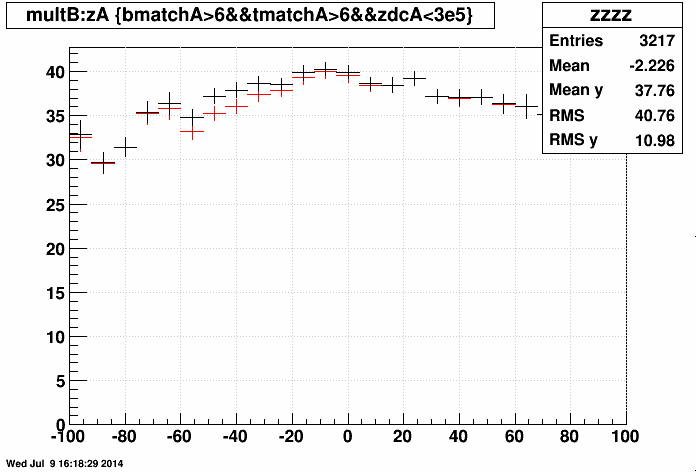
Looking at a vertex-by-vertex comparison of <Δ(multiplicity)> vs. z isolates this effect better:
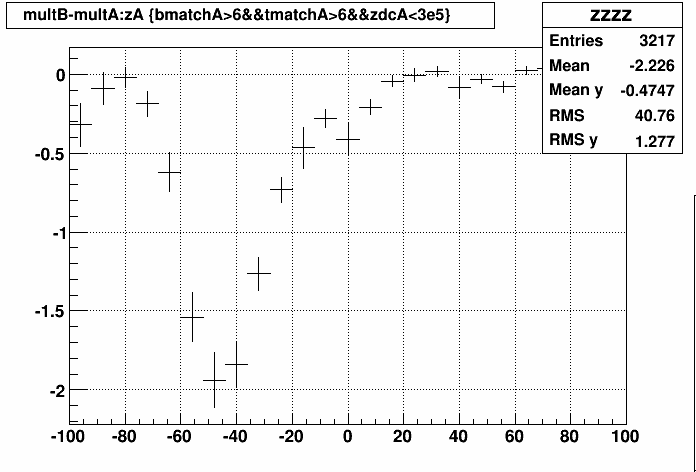
The effect actually becomes stronger with vertex quality cuts (e.g. number of matched daughters to fast detectors), so it is likely an effect on triggered collisions, and less so on pile-up collisions. Also curiously, the effect seems to be reflected more clearly in the <number of daughters matched to EEMC> (first plot) than in <number of daughters matched to BEMC> (second plot), though the latter highlights a smaller but similar effect at a different z, close to the center:
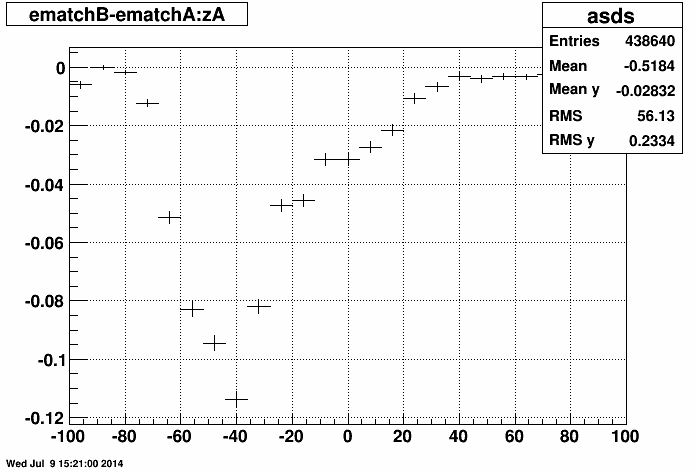
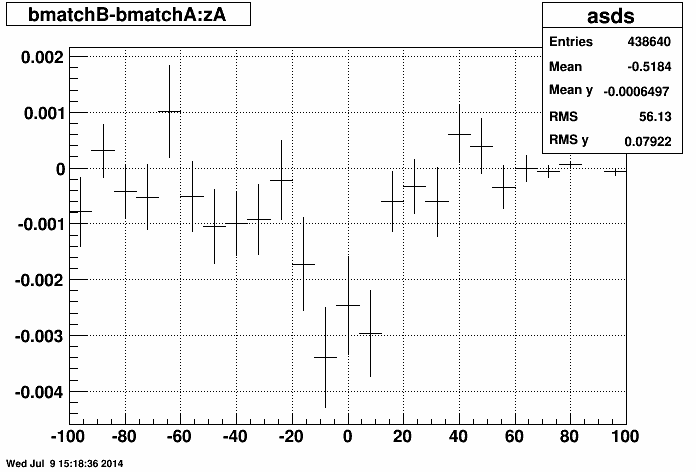
This remains an open observation. A more positive (and expected) observation is that vertices at large positive z are essentially unaffected by the material accounting.
_______________
Anyhow, moving on to the calibration itself...
...
Preliminary calibration, showing the issue, presented at Sept. 2013 S&C meeting:
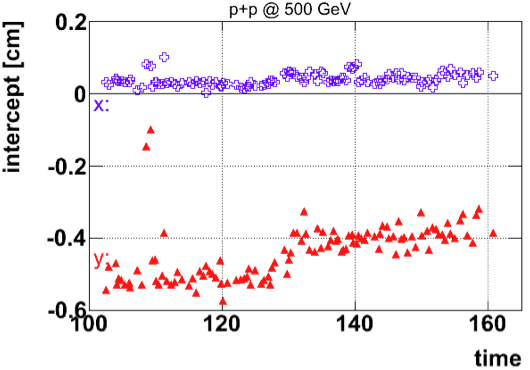
Final calibration of Run 13 data without PXL:
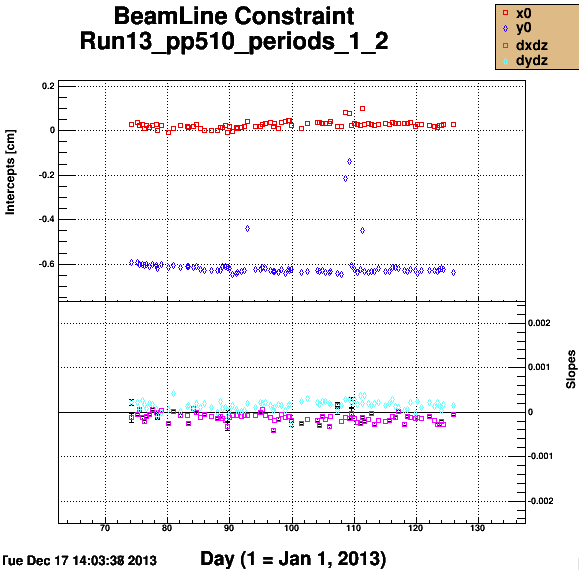
The above indicates that we are ooking for a y intercept (y0) of about -0.62 cm. I have the new result for with and without the StiHftP opion. The values are shown in the following plot of <y> vs. z for with HFT materials (red) and without (black). The values of the intercept are within ~10 microns of each other, and both are ~500 microns (half millimeter) above what we're expecting. While ~500 microns is more than a factor of two closer than the 1+ mm that we saw last September, it's clear that essentially all of the gains are from the new SpaceCharge & GridLeak calibration, and not the accounting of HFT materials in tracking for the BeamLine calibration.

-Gene
- Geometry accounting may not be complete
- Asymetric SpaceCharge & GridLeak calibration...
- ...dependent on material accounting for accurate calibration
- ...and not final (using a preliminary result before calibration has converged)
Ran twice: with and without Sti accounting of HFT materials (i.e. StiHftP BFC chain option).
I looked for differences due to the material accounting and found some curious results on vertex multiplicity (number of daughter tracks). It seems that including the material (red) reduces <multiplicity> of vertices at a region of z compared to no HFT material accounting (black):

Looking at a vertex-by-vertex comparison of <Δ(multiplicity)> vs. z isolates this effect better:

The effect actually becomes stronger with vertex quality cuts (e.g. number of matched daughters to fast detectors), so it is likely an effect on triggered collisions, and less so on pile-up collisions. Also curiously, the effect seems to be reflected more clearly in the <number of daughters matched to EEMC> (first plot) than in <number of daughters matched to BEMC> (second plot), though the latter highlights a smaller but similar effect at a different z, close to the center:


This remains an open observation. A more positive (and expected) observation is that vertices at large positive z are essentially unaffected by the material accounting.
_______________
Anyhow, moving on to the calibration itself...
...
Preliminary calibration, showing the issue, presented at Sept. 2013 S&C meeting:

Final calibration of Run 13 data without PXL:

The above indicates that we are ooking for a y intercept (y0) of about -0.62 cm. I have the new result for with and without the StiHftP opion. The values are shown in the following plot of <y> vs. z for with HFT materials (red) and without (black). The values of the intercept are within ~10 microns of each other, and both are ~500 microns (half millimeter) above what we're expecting. While ~500 microns is more than a factor of two closer than the 1+ mm that we saw last September, it's clear that essentially all of the gains are from the new SpaceCharge & GridLeak calibration, and not the accounting of HFT materials in tracking for the BeamLine calibration.

-Gene
Groups:
- genevb's blog
- Login or register to post comments
